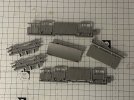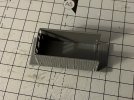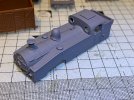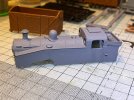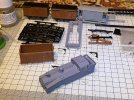Evening all,
Done my usual trick and forgotten to update this thread again! Not a huge amount of progress in the last couple of months, but satisfyingly things have moved on a bit in the last couple of weeks!
My wagon fleet has expanded to three, nearly four wagons. In addition to the GWR Mogo van that was mentioned previously, which is now equipped with four 3mm Society white metal buffers, a 12-ton Vent Van and the Cambrian Models LMS Brake Van have been completed and wheeled. All three now await painting and transfers once the better weather gets here, but more immediately maybe next week will be the creation and fitting of DG Couplings. My next target is another Society kits in the form of a BR 21-ton hopper, the body of which is part way through construction.
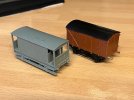
Elsewhere, I have built my J50 white metal body. This is a 3SMR white metal kit but goes together very well. The castings were, in the main, nice and sharp, with minimal cleaning up needed. The one exception was the buffers, which had quite a bit of flash on them. My plan is to remove the white metal buffers and add Society LNER loco buffers in their place. The main focus of attention is now on creating a chassis for this. 3SMR do one, but I wanted to try out a few things and also prove to myself that I can design a chassis. There are bigger Pacifics to come further down the line if this initial experiment works and I want to know ive got the skill to do it.
The plan for the J50 is my own etched Nickel Silver chassis, with 3mm Society 14.2mm gauge finescale wheels, driven through a High Level Kits Slimliner 54:1 gearbox using a HLK Coreless motor. The gearbox and motor arrived this morning, so I'll build that when I have chance and then lift the various measurements to allow the design of the chassis frames in such a way at the gearbox and motor sit in nicely.
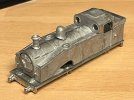
The body is quiet nice and well detailed, but I think some bits may get rubbed down, such as the handrails and replaced with proper wire ones and I am not totally happy with the smokebox door and how it sits.
Sorry, these are just iPhone images and the quality isnt the best through lack of light and less than ideal photographing location! Another little project that I am on with is a 3mm display diorama, initially for photographing the stock on, but built in such away that a couple of extra boards could be added to turn it into a little layout, with return loops on each side.
Both boards will be A4 sized to go into Really Useful Boxes for storage when not in use, the track layout is nothing complicated, just a couple of sidings set on an embankment, surrounded by trees. Something to be able to test my loco on when built, to run the wagons up and down and see how they ride. Also a chance to try my hand at scenic modelling that I have not really done in many years! More on that coming up, but a sneak peak at the basic track layout and board design is below...

I have taken the Templot drawing for the track work and imported this into Fusion360, the CAD package I use, to be able to build the wooden frame around it, which I am then going to have CNC or laser cut. I like building things, but precise woodworking with straight cut lines is definitely not my forte!
This is in essence two boards - Board A is just the double track running through scenary, (left half) while Board B is the double track, point and three sidings. (right hald). The board design (as it currently stands, unfinished) using 9mm birch ply for the outer base of Board B is included below:
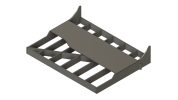
I am hoping that the design may go off to the cutters by the end of next week as there is a 3mm East Midlands Group meeting that I am hoping to get to in mid-April, and I'd like to take it a long, although its not going to be anywhere near finished!
Richie

www.cambrianmodelrail.co.uk


